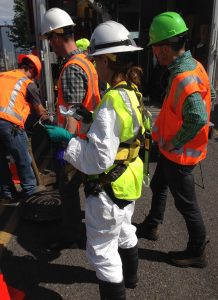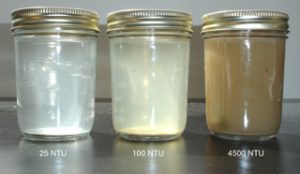Your employees are the front line of defense when it comes to protecting stormwater runoff quality. Industrial stormwater discharge permits include requirements for employee stormwater awareness and best practices training.
Regulators know that employees’ day to day operations are the best way to keep pollutants from entering stormwater in the first place. It is always easier and more cost-effective to prevent pollution from entering the stormwater stream than to try to treat it after the fact. While each state and the EPA have different training requirements (read your permit carefully), the following general principles are common to most permits.
Who Should be Trained?
Employees that have the potential to work with materials that could come in contact with stormwater should participate in stormwater awareness training. This typically includes:
- Janitorial staff
- Material handlers (e.g. forklift and loader operators)
- Operators of process equipment that is outside of buildings
- Maintenance staff
- Spill responders
- Vehicle fueling and maintenance operators, and
- Supervisors and Management
Consider also training contractors and vendors (such as material delivery vendors and maintenance contractors) that are onsite frequently and have the potential to impact your stormwater quality.
When Should Training Occur?
Most permits require that employees be trained on stormwater practices within a short time from hire or when an employee first assumes a position that could affect stormwater quality. A typical timeframe in permits is 30 days from date of hire or reassignment.
Although most permits only require minimum training on an annual basis, it has been shown to be beneficial to increase the amount of training within the year which increases the effectiveness of the stormwater program. Include updates on performance and discuss issues that are found during monthly inspections at regular staff meetings, where possible. Also, consider retraining on specific issues as part of any corrective action along with a review of your Stormwater Pollution Prevention Plan (SWPPP) and Best Management Practices (BMPs).
What to Cover?
You may want to provide a general awareness training for all staff that have a potential to affect stormwater quality and additional (external or internal) training for your Stormwater Pollution Prevention Team, Spill Responders, and operators of any stormwater treatment systems. At a minimum, general awareness stormwater training should include:
- Safety considerations associated with inspections and sampling
- Location and content of your site-specific SWPPP
- BMPs implemented at your facility including, at a minimum:
- Good housekeeping practices
- Maintenance requirements
- Material management practices
- Evaluation of BMP effectiveness
- Visual observations for evidence of stormwater impacts (illicit discharges) and BMP function
- Monitoring requirements
- Spill response and reporting
- Erosion control during construction/maintenance activities
- Site-specific processes for continuous improvement of BMPs
Here are some suggestions for making training more effective and meaningful:
- Include periodic hands-on in-the-field training, such as doing a monthly inspection as a group, or conducting a spill response drill.
- Look for resources such as new videos or presentations from your trade associations and stormwater groups.
- Make the training site specific to your operations.
- Discuss issues and inspection findings that have come up since the last training event.
- Involve employees in developing and teaching subjects during the training.
Be sure to include the reasons why stormwater quality is important (e.g. the toxicity of zinc and copper to fish) and provide concrete examples that employees can relate to about how a small amount of pollution can trigger costly corrective actions.
Certain industry categories may be subject to additional specific training requirements (part of federal Effluent Limitation Guidelines) based on standard Industry classification (SIC) codes. Again, read your permit carefully.
Who Can Provide Training?
Typically training can be provided in-house and most permits do not have specific train-the-trainer requirements for facilities that are in compliance. However, the trainer should have knowledge about stormwater best practices and be conversant with the SWPPP and permit. Some permits require additional training for stormwater compliance leaders when sampling has triggered elevated corrective actions. For example, the California Stormwater Industrial General Permit requires that a facility or group of facilities that are in Level 1 corrective action designate and train a Qualified Industrial Stormwater Professional (QISP) through an agency-approved train-the-trainer provider. There are specific topics and requirements that must be covered to become a QISP.
There are numerous resources for training providers, online courses, and materials. Here are just a few (no endorsement is implied):
- EPA’s website stormwater training resources: http://water.epa.gov/polwaste/npdes/NPDES-Training-Courses-and-Workshops.cfm#sw
- California Stormwater Quality Association: https://www.casqa.org/resources/qsp-qsd-qualification
Document the Training!
In the eyes of regulators, if it isn’t documented, it didn’t happen. Prepare a sign-in roster that includes employee names, signatures and a date. On the back of the roster, summarize the topics covered and the amount of time spent on training. Consider including a short quiz at the end of your training event so each employee can demonstrate his or her participation and understanding.
If you are interested in more information on Kennedy Jenks, don’t forget to subscribe to our blog!



